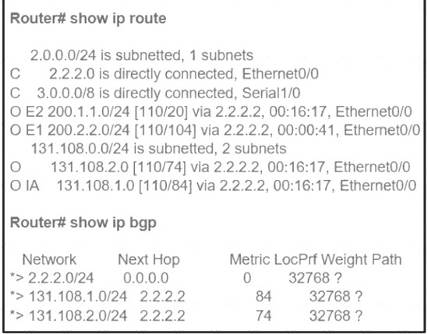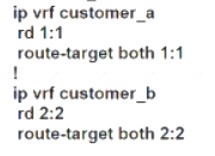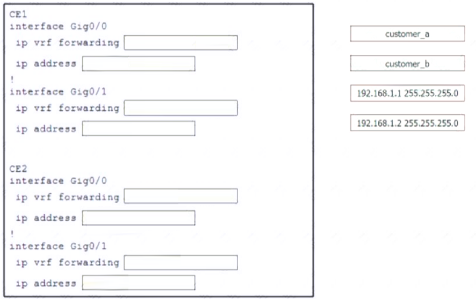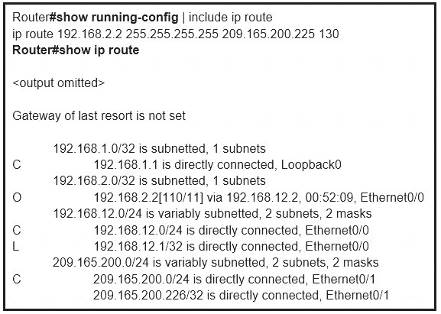- (Exam Topic 2)
An engineer must configure a Cisco router to initiate secure connections from the router to other devices in the network but kept failing. Which two actions resolve the issue? (Choose two.)
Correct Answer:
DE
Follow these guidelines when configuring the switch as an SSH server or SSH client:
+ An RSA key pair generated by a SSHv1 server can be used by an SSHv2 server, and the reverse.+ If the SSH server is running on a stack master and the stack master fails, the new stack master uses the RSA key pair generated by the previous stack master
+ If you get CLI error messages after entering the crypto key generate rsa global configuration command, an RSA key pair has not been generated. Reconfigure thehostname and domain, and then enter the crypto key generate rsa command.+ When generating the RSA key pair, the message No host name specified might appear. If it does, you must configure a hostname by using the hostname globalconfiguration command.+ When generating the RSA key pair, the message No domain specified might appear. If it does, you must configure an IP domain name by using the ip domain-nameglobal configuration command.+ When configuring the local authentication and authorization authentication method, make sure that AAA is disabled on the console.
Reference:https://www.cisco.com/en/US/docs/switches/lan/catalyst3850/software/release/3.2_0_se/multibook/co
- (Exam Topic 2)
Refer to the exhibit.
The OSPF routing protocol is redistributed into the BGP routing protocol, but not all the OSPF routes are distributed into BGP Which action resolves the issue?
Correct Answer:
C
If you configure the redistribution of OSPF into BGP without keywords, only OSPF intra-area and inter-area routes are redistributed into BGP, by default. You can use the internal keyword along with the redistribute command under router bgp to redistribute OSPF intra- and inter-area routes.
Use the external keyword along with the redistribute command under router bgp to redistribute OSPF external routes into BGP.
-> In order to redistribute all OSPF routes into BGP, we must use both internal and external keywords. The full command would be (suppose we are using OSPF 1):
redistribute ospf 1 match internal external
Note: The configuration shows match internal external 1 external 2. This is normal because OSPF automatically appends “external 1 external 2” in the configuration. In other words, keyword external = external 1 external 2. External 1 = O E1 and External 2 = O E2. Reference:
https://www.cisco.com/c/en/us/support/docs/ip/border-gateway-protocol-bgp/5242-bgp-ospf-redi s.html
- (Exam Topic 3)
An engineer must establish a connection between two CE routers for two customers with overlapping IP addresses Customer_a is connected to interfaces Gig0/0, and Customer_b is connected to interfaces Gig0/1. Routers CE1 and CE2 are configured as follows:
Drag and drop the code snippets from the right onto the boxes in the configuration to establish the needed connection. Snippets may be used more than once.
Solution:
Does this meet the goal?
Correct Answer:
A
- (Exam Topic 3)
Refer to the exhibit. The ISP router is fully configured for customer A and customer B using the VRF-Lite feature. What is the minimum configuration required for customer A to communicate between routers A1 and A2?
Correct Answer:
C
A1 and A2 routers do not know they belong to VRF A. The two
interfaces of ISP (which are connected to A1 & A2) should be configured like this (we only show the configure of one interface):
ISP router:
interface g0/0
description ISP->To_CustomerA ip vrf forwarding A
ip address 172.31.100.2 255.255.255.0
router ospf 100 vrf A
network 172.31.200.2 0.0.0.255 area 0
- (Exam Topic 1)
Refer to the exhibit.
An engineer configures a static route on a router, but when the engineer checks the route to the destination, a different next hop is chosen. What is the reason for this?
Correct Answer:
C
The AD of static route is manually configured to 130 which is higher than the AD of OSPF router which is 110.

